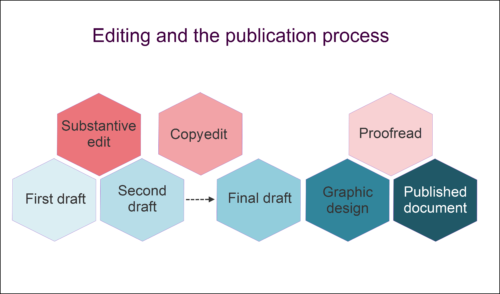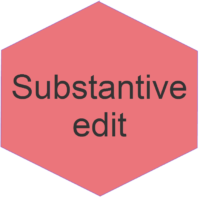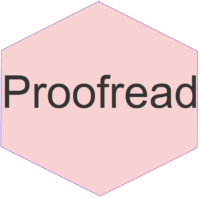Editing services
Levels of editing
I offer three levels of editing:
- substantive editing — when you would like the structure, content and clarity checked before continuing to a copyedit
- copyediting — when you are happy with the structure and content, but need language, consistency, spelling, grammar and punctuation checked
- proofreading — when structure, content, and language are finalised, your document has been graphically designed its final format, and you need someone to do a final check (completeness, correctness, illustrations, layout).

Tools
I use the ‘track changes’ feature in MS Word to show all recommended text changes. When required, I use MS Word ‘comments’ to explain these editorial recommendations.
 Substantive editing
Substantive editing
The substantive edit is the first edit after you have completed a first draft of your document. This thorough edit aims to improve not only language and style, but also the structure and content presentation.
It looks at the aims of the document, who will be reading it, and what the purpose of the document is.
A substantive edit includes:
- a content structure review
- checking the clarity of content presentation
- checking the style and language.
 Content structure review
Content structure review
The most important component of a substantive edit is the content structure review.
For a structural review, I look in detail at the content presentation. It is very important that the content presentation is logical and easy to follow. In some cases, content may need rearranging or rewriting, or additional information may be required.
Return to top
 Clarity of presentation
Clarity of presentation
The content structure review goes hand in hand with an assessment of the clarity of presentation. To assess clarity, I check section and subsection headings and numbering, to see if they are easy to follow and reflect what is presented in the sections and subsections.
I also check internal navigation aids such as cross-references, hyperlinking (for online content) and references, which are all elements that can help the reader navigate and understand the document.
 Style and language
Style and language
The third element of the substantive edit is checking the style and language. I check that the language is appropriate for the intended audience and that it is consistent throughout the document. I check for clear presentation of the information and remove unnecessary repetition and contradictions.
The use of specialist language is appropriate if the intended audience is a specialist audience (as in scientific publications). However, often the audience can be both specialist and non-specialist. In that case, rewording some of the specialist terminology will include a slightly wider audience and can be beneficial.
![]() I am happy to provide a quote for substantive editing if you provide a relevant sample chapter of your document.
I am happy to provide a quote for substantive editing if you provide a relevant sample chapter of your document.
 Copyediting
Copyediting
A copyedit is intended for documents that have had a substantive edit or for which you are certain they have good structure and content.
Copyediting includes checking:
- language
- consistency
- tables, figures, lists, boxes and other illustrations
- references, cross-references and bibliography.
A copyedit does not include significant rewriting; however, it may include rewording to improve language.
 Language
Language
This includes checking:
- grammar
- spelling
- punctuation
- text flow.
I also ensure that my edits will be consistent with your organisation’s style, publication and accessibility recommendations.
 Consistency
Consistency
Checking for consistency is a main part of copyediting. A document will be much easier to read and follow if the terminology, and capitalisation and hyphenation of terms is consistent throughout.
The same is true for the use of abbreviations and specialist terminology.
 Tables, figures, lists, boxes and other illustrations
Tables, figures, lists, boxes and other illustrations
Standardising the titles and/or captions of tables, figures or other illustrations is another element that improves readability.
I also check for visual consistency, including page layout (if required), paragraph indentation, illustration presentation, footnote and endnote presentation, references, hyperlinking, etc.
 References, cross-references and bibliography
References, cross-references and bibliography
Where required, I do extensive checking of references and cross-references, and bibliography style. See also bibliographic database services.
![]() I am happy to provide a quote for copyediting if you provide a sample chapter of your document.
I am happy to provide a quote for copyediting if you provide a sample chapter of your document.
 Proofreading
Proofreading
A proofread is the last check before publishing your document in print or electronic format, or online.
At this stage, your document has already been edited and is made available for proofreading in its final publication format.
This can be MS Word, but, more likely, it will be in a designer format that produces a PDF for proofreading.
 Checks
Checks
Proofreading includes checking:
- completeness (making sure all components from the final draft are present in the designed draft)
- correctness (reading the entire document and correcting errors and typos, checking page numbers, headings, headers and footers, cross-references)
- tables, figures, boxes and other illustrations (checking these are correctly numbered, complete and consistent, and sufficiently high in resolution)
- layout (making sure layout is logical and consistent throughout).
 Tools
Tools
Commenting on a PDF is time-consuming and therefore I usually deliver a hard-copy draft that is marked up.
![]() I am happy to provide a quote for proofreading if you provide a relevant sample of your document.
I am happy to provide a quote for proofreading if you provide a relevant sample of your document.
Botanical editorial services
I have a background in systematic botany and offer specialist editing services for botanical and environmental publications. These include botanical name checking, fact checking, and bibliographical databases on specialist literature.
Cost details
Editing costs are calculated at an hourly rate, based on the type of document and complexity of subject matter.
Contact me

 Substantive editing
Substantive editing Copyediting
Copyediting Proofreading
Proofreading